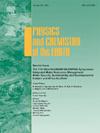巴基斯坦斯瓦特河流域泥沙负荷预测的LSTM优化:优化器和激活函数的评价
IF 3
3区 地球科学
Q2 GEOSCIENCES, MULTIDISCIPLINARY
引用次数: 0
摘要
准确估算泥沙负荷对于水资源的可持续管理至关重要,因为过量的泥沙会降低水库容量,降低水质,损害水生生态系统,最终影响长期规划和基础设施设计。然而,由于机器学习模型中优化器和激活函数的选择,预测可能不确定。本研究考察了7个优化器(Adam、RMSprop、Adagrad、Adadelta、Adamax、Nadam和Ftrl)和8个激活函数(ELU、Sigmoid、Linear、Softplus、Swish、SELU、Tanh和Softmax)对用于泥沙负荷预测的长短期记忆(LSTM)网络性能的影响。利用巴基斯坦斯瓦特河流域Chakdara站的历史数据,共测试了56种优化器激活组合。使用Min-Max缩放对数据集进行规范化,训练测试分割为70:30。使用决定系数(R2)、均方误差(MSE)、平均绝对误差(MAE)、均方根误差(RMSE)和百分比偏差(PBIAS)来评估模型的性能。结果表明,Adam-SELU组合在训练时的R2为0.81,MSE为1363.61,RMSE为36.93,测试时的R2为0.80,MSE为2385.2,RMSE为48.84,达到最佳效果。这种配置也表现出最小的偏差,PBIAS值为- 1.07(训练)和- 1.04(测试)。其他组合,如Adam-Nadam和Adam-RMSprop,表现相对较好,但误差指标较高。研究结果强调Adam-SELU是最有效的泥沙负荷预测配置,提供了更高的准确性。这些见解可以指导流域管理者选择可靠的泥沙预测模型。本文章由计算机程序翻译,如有差异,请以英文原文为准。
Optimizing LSTM for sediment load prediction in the Swat river basin, Pakistan: Evaluation of optimizers and activation functions
Accurately estimating sediment load is essential for sustainable water resources management, as excessive sedimentation can reduce reservoir capacity, degrade water quality, and impair aquatic ecosystems, ultimately affecting long-term planning and infrastructure design. However, predictions can be uncertain due to the choice of optimizers and activation functions in machine learning models. This study investigates the influence of seven optimizers (Adam, RMSprop, Adagrad, Adadelta, Adamax, Nadam, and Ftrl) and eight activation functions (ELU, Sigmoid, Linear, Softplus, Swish, SELU, Tanh, and Softmax) on the performance of a Long Short-Term Memory (LSTM) network for sediment load prediction. A total of 56 optimizer-activation combinations were tested using historical data from the Chakdara station in the Swat River basin, Pakistan. The dataset was normalized using Min-Max scaling, with a 70:30 train-test split. Model performance was evaluated using the Coefficient of Determination (R2), Mean Squared Error (MSE), Mean Absolute Error (MAE), Root Mean Squared Error (RMSE), and Percent Bias (PBIAS). Results showed that the Adam-SELU combination achieved the best performance, with an R2 of 0.81, MSE of 1363.61, and RMSE of 36.93 during training, and an R2 of 0.80, MSE of 2385.2, and RMSE of 48.84 during testing. This configuration also exhibited minimal bias, with PBIAS values of −1.07 (training) and −1.04 (testing). Other combinations, such as Adam-Nadam and Adam-RMSprop, performed relatively well but with higher error metrics. The findings highlight Adam-SELU as the most effective configuration for sediment load prediction, offering improved accuracy. These insights can guide watershed managers in selecting robust models for sediment forecasting.
求助全文
通过发布文献求助,成功后即可免费获取论文全文。
去求助
来源期刊

Physics and Chemistry of the Earth
地学-地球科学综合
CiteScore
5.40
自引率
2.70%
发文量
176
审稿时长
31.6 weeks
期刊介绍:
Physics and Chemistry of the Earth is an international interdisciplinary journal for the rapid publication of collections of refereed communications in separate thematic issues, either stemming from scientific meetings, or, especially compiled for the occasion. There is no restriction on the length of articles published in the journal. Physics and Chemistry of the Earth incorporates the separate Parts A, B and C which existed until the end of 2001.
Please note: the Editors are unable to consider submissions that are not invited or linked to a thematic issue. Please do not submit unsolicited papers.
The journal covers the following subject areas:
-Solid Earth and Geodesy:
(geology, geochemistry, tectonophysics, seismology, volcanology, palaeomagnetism and rock magnetism, electromagnetism and potential fields, marine and environmental geosciences as well as geodesy).
-Hydrology, Oceans and Atmosphere:
(hydrology and water resources research, engineering and management, oceanography and oceanic chemistry, shelf, sea, lake and river sciences, meteorology and atmospheric sciences incl. chemistry as well as climatology and glaciology).
-Solar-Terrestrial and Planetary Science:
(solar, heliospheric and solar-planetary sciences, geology, geophysics and atmospheric sciences of planets, satellites and small bodies as well as cosmochemistry and exobiology).
 求助内容:
求助内容: 应助结果提醒方式:
应助结果提醒方式:


